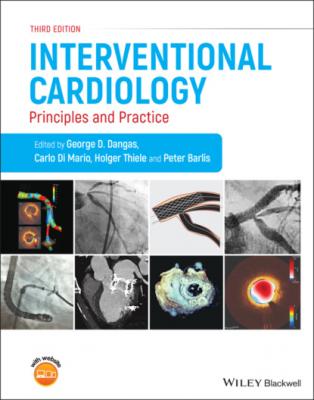Interventional Cardiology. Группа авторов
Читать онлайн.| Название | Interventional Cardiology |
|---|---|
| Автор произведения | Группа авторов |
| Жанр | Медицина |
| Серия | |
| Издательство | Медицина |
| Год выпуска | 0 |
| isbn | 9781119697381 |
Colchicine, another anti‐inflammatory drug widely used for gout and pericarditis, has been examined to have a beneficial effect on cardiovascular disease, which showed the reduction of ischemic cardiovascular events in patients with MI [199], whereas a further trial investigating the efficacy of another anti‐inflammatory drug of methotrexate, most commonly used for arthritis, on patients with coronary artery disease was stopped given that it did not result in the lowering of IL‐1beta, IL‐6 or hs‐CRP compared to placebo and was associated with raised liver enzymes, reduction in leukocytes and hematocrit and a higher incidence of non‐basal cell skin cancer compared to placebo [200]. Thus, given unclear the anti‐inflammatory protective mechanism further investigation is required to better understand the association between inflammation and atherosclerotic disease.
Cellular adhesion molecules can be considered potential markers of vulnerability since such molecules are activated by inflammatory cytokines and then released by the endothelium.201 These molecules represent the one available marker to assess endothelial activation and vascular inflammation. The Physicians’ Health Study evaluated more than 14 000 healthy subjects and demonstrated ICAM‐1 expression positive correlation with cardiovascular risk and showed that subjects in the higher quartile of ICAM‐1 expression showed 1.8 times higher risk compared to subjects in the lower quartile [202]. Furthermore, soluble ICAM‐1 and VCAM‐1 levels showed a positive correlation with atherosclerosis disease burden [203]. IL‐6 is expressed during the early phases of inflammation and it is the principle stimuli for CRP liver production. In addition, CD 40 ligand, a molecule expressed on cellular membrane, is a TNF‐α homologue which stimulates activated macrophages proteolytic substances production.204 CD40 and CD40L have been found on platelets and several other cell types in functional‐bound and soluble (sCD40L) forms. Although many platelet‐derived factors have been identified, recent evidence suggests that CD40L is actively involved in the pathogenesis of acute coronary syndrome (ACS). CD40L drives the inflammatory response through the interaction between CD40L on activated platelets and the CD40 receptor on endothelial cells. Such interactions facilitate increased expression of adhesion molecules on the surface of endothelial cells and release of various stimulatory chemokines. These events, in turn, facilitate activation of circulating monocytes as a trigger of atherosclerosis. Beyond known proinflammatory and thrombotic properties of CD40L, experimental evidence suggests that CD40L‐induced platelet activation leads to the production of reactive oxygen and nitrogen species, which are able to prevent endothelial cell migration and angiogenesis [205]. As a consequence of inhibiting endothelial cell recovery, the risk of subsequent coronary events may be greater. Clinical studies have supported the involvement of CD40L in ACS and the prognostic value in ACS populations. Levels of sCD40L have been shown to be an independent predictor of adverse cardiovascular events after ACS [206] with increased levels portending a worse prognosis [207]. Importantly, specific therapeutic strategies have shown to be beneficial in reducing risk associated with sCD40L [208]. IL‐18 is a pro‐inflammatory cytokine mostly produced by monocytes and macrophages, and it acts synergistically with IL‐12 [176]. Both these interleukines are expressed in the atherosclerotic plaque and they stimulate IFN‐γ induction which, on its turn, inhibits collagen synthesis, preventing a thick fibrous cap formation and facilitating plaque destabilization. Mallat et al. [209] examined 40 stable and unstable atherosclerotic plaques obtained from patients undergoing carotid endarterectomy and they highlighted how IL‐18 expression was higher in macrophages and endothelial cells extracted from unstable rather than stable lesions and it correlated with clinical (symptomatic plaques) and pathological (ulceration) signs of vulnerability (Figures 1.7 and 1.8).
Pregnancy Associated Plasma Protein‐A (PAPP‐A), is a high‐molecular‐weight, zinc‐binding metalloproteinase, typically measured in women’s blood during pregnancy and later found in macrophages and smooth muscle cells inside unstable coronary atherosclerotic plaques. This protease cleaves the bond between Insulin Like Growth Factor‐1 (IGF‐1) and its specific inhibitor (IGFBP‐4 e IGFBP‐5), increasing free IGF‐1 levels. IGF‐1 is important for monocytes‐macrophages chemotaxis and activation in the atherosclerotic lesion, with consequent pro‐inflammatory cytokine and proteolytic enzyme release, and stimulates endothelial cell migration and organizational behaviour with consequent neo‐angiogenesis. Hence, IGF‐1 represents one of the most important mediators in the transformation of a stable lesion into an unstable one [210]. Bayes‐Genis et al. [211] demonstrated that PAPP‐A is more expressed in the serum of patients with acute coronary syndromes (unstable angina, myocardial infarction), compared to subjects presenting with stable angina. In particular, PAPP‐A serum levels > 10 mIU/l recognize patient vulnerability with a specificity of 78% and a sensibility of 89%. It has also been demonstrated that PAPP‐A histological expression is higher in complex, vulnerable/ruptured carotid plaques compared to stable lesions [212]. Since PAPP‐A serum levels can be easily measured today by means of ELISA, this protease could represent an easily quantifiable marker of vulnerability, with a reproducible method, allowing the identification of a patient subgroup with a high cerebrovascular risk, before its clinical event manifestation.
Figure 1.7 Schematic diagram of a stable atherosclerotic plaque characterized by the presence of a low inflammatory infiltrate. This type of lesion is constituted by a lipid core (extracellular lipid, cholesterol crystals and necrotic debris) covered by a thick fibrous cap consisting principally of smooth muscle cells in a collagenous‐proteoglycan matrix, with varying degrees of infiltration by macrophages and T lymphocytes.
Figure 1.8 Unstable atherosclerotic plaque characterized by the presence
